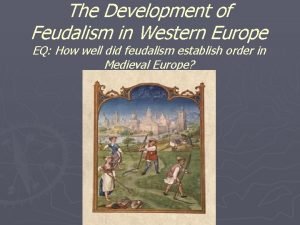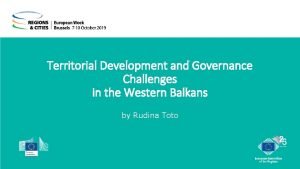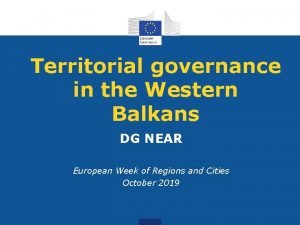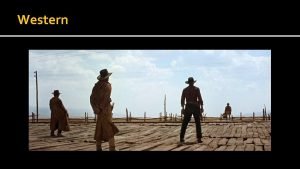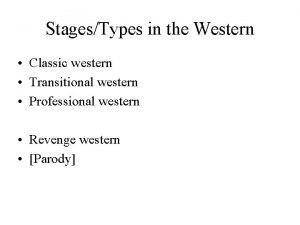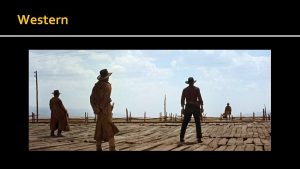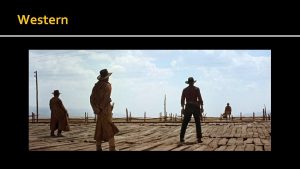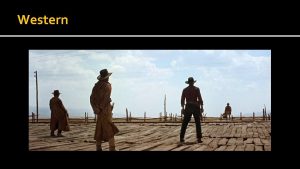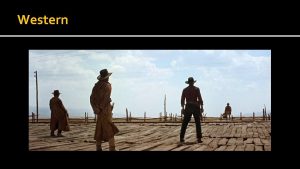Territorial governance as development chance for the Western










- Slides: 10

Territorial governance as development chance for the Western Balkans Multilevel stakeholder governance in the EUSAIR Giuseppe Di Paola EUSAIR Coordinator DG REGIO

Why the EUSAIR? • Territorial Governance is the formulation of public policies, programmes and projects for the development of a territory by: 1) 2) 3) 4) 5) coordinating actions of actors and institutions Integrating policy sectors Mobilising stakeholders participation Being adaptive to changing contexts Realising place based/territorial specificities and impacts Definition by: “Towards a Better Territorial Governance in Europe”, ESPON, 2014 MRS are forms of territorial governance on a larger scale

EUSAIR Governance Structure • Multilevel and Multisector Governance by involving: • - Ministry of Foreign Affairs and EU funds authorities (GB) • - Line Ministries (TSGs) • - Stakeholders (Annual Forum, Stakeholders Platoform) • EC involved at all levels of the process

PILLAR 2 Connecting the Region PILLAR 3 Environmental Quality THEMATIC STEERING GROUP Transport THEMATIC STEERING GROUP - Topic 1. 1 - Topic 1. 2 - Topic 1. 3 -Topic 2. 1 -Topic 2. 2 - Topic 3. 1 a + b - Topic 3. 2 Energy - Topic 2. 3 - STAKEHOLDERS PLATFORM PILLAR 4 Sustainable Tourism THEMATIC STEERING GROUP - Topic 4. 1 - Topic 4. 2 Supporting EUSAIR governance and implementation PILLAR 1 Blue Growth ADRIATIC –IONIAN TRANSNATIONAL PROGRAMME EUSAIR GOVERNING BOARD

How to make it work • Common objectives: • - More developed, competitive, innovative, connected, attractive region • HOW? • More Coordination across levels and sectors • More Ownership via better internal and external communication of EUSAIR potential • More Administrative capacity by attributing clear responsibilities to each actor)

COORDINATION CHALLENGES OECD Synthesis report on multi-level governance in the EUSAIR • Cross-sector. Both internally and at EUSAIR level. There is limited interaction between EUSAIR Pillars. • Vertical. In general sub-regional levels not fully involved in the Strategy. Need to increase involvement and commitment. • Horizontal. More coordination needed between EU-funded programmes and EUSAIR governance (embedding challenge)(e. g. Managing Authorities network in the Baltic sea region).

EUSAIR Internal Governance SERBIA • NC – MFA + EU Funds • PC and TSG members (line ministries) • Sub-national governments do not participate to EUSAIR multilevel governance in Serbia (Vojvodina indirectly involved providing cofinancing opportunities – project level) • Good level of involvement of non gov stakeholders (academia, research centres, NGOs. . ) • Coordination. Working Group for Cooperation (EUSAIR)

POST-2020 Territorial Governance (PO 5) • PO 5 (A Europe closer to citizens) will be especially dedicated to territorial governance. • - incentives for integrated territorial development strategies targeting functional territories • - thematic flexibility (respond to interdependent challenges combining intervention fields (PO 1 to PO 5) • - special governance method

Elements of integrated territorial development under PO 5 1. Multi-sectoral strategic approach 2. Multi-level governance approach (from programming to implementation and monitoring 3. Multi-stakeholders approach 4. Functional area approach 5. Bottom-up participatory approach (e. g. CLLD)

Integrated Territorial Development Shared management What is integrated? Multi-sectoral (Partnership + Multi-level governance) Multi-level Multi-stakeholder Multi-territorial Community-led What is Integrated territorial development? (Art. 22) Policy objective 5 + territorial instruments - ITI (PO 1 -5) - CLLD (PO 1 -5) - Other (PO 5) COHESION POLICY Integrated Place-based Macroregional strategies Transnational/cross-border Partnership Agreement National Programmes Regional/national Territorial strategies (Art. 23) Functional (Functional urban area) Local strategies (Art. 26) Subregional (metropolitan region) Local admin (City/town/suburb) Community (urb. neighbourhood)
